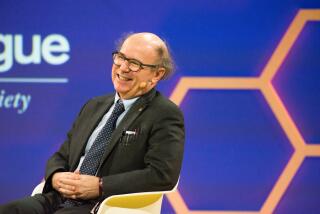Scientists’ Attempt to See a Bigger Picture
- Share via
At least Michael Gilmore admits what many of us have long suspected -- Darwinians are just as religious as anyone (“Feeling at Home in a Scientific World,” Commentary, Feb. 11). He waxes poetic about finding a “true religious sense” in evolution, in a blind universe where we can be “star stuff contemplating star stuff.”
I’m sorry if I’m not moved by that. Darwinism is a religion with a profoundly empty source. The supposed “facts” of purposeless descent are being increasingly exposed as fallacious. Professor Michael Behe’s groundbreaking work on irreducible complexity (see “Darwin’s Black Box”), professor Phillip Johnson’s unfrocking of Darwinism’s presuppositions (see “Darwin on Trial”) and Jonathan Wells’ unmasking of outright fraudulent claims (see “Icons of Evolution”) are a mere sampling of a new wave washing over the evolution debate. Robust intelligent-design theorists are beginning to be heard in the scientific community, in part because attempts to silence them have been met with an intellectual rigor that cannot be ignored.
It is becoming apparent that the universe, and life, was designed for a purpose. That can be a scary thought for committed Darwinists. For a century and a half they have been trying to scale the mountain of knowledge. But as they pull themselves up to the summit they are finding, as astrophysicist Robert Jastrow once put it, a group of theologians who have been waiting for them for years.
James Scott Bell
Woodland Hills
*
Why do defenders of science have such a self-destructive impulse? Darwin was a great scientist whose theories are still helping us better understand the world. Why can’t it be left at that?
Saying “evolution is as certain as the existence of atoms” demolishes one’s credibility. To many, evolution means all life descended from single-celled organisms or, worse, from a lifeless primordial stew. Thank God there aren’t many who believe that the creation of mankind was limited to putting some chemical and physical laws in place and then letting a microscopic spot of matter explode.
John Surlow
Long Beach






